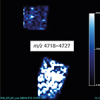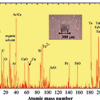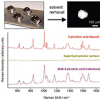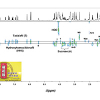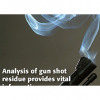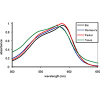Articles
This article highlights the versatility of the developed methodology for the measurement of arsenic species in a range of materials from Devon Great Consols (DGC), one of many former mining sites in the south- west of England.
This article shows that MALDI high resolution mass spectrometry demonstrated directly that Hev b 6 and Hev b 1, and also truncated forms thereof, are present on the inner surface of medical NRL gloves. The speed and high accuracy of the applied method and instrumentation makes the detection of surface associated proteins feasible without any prior protein extraction procedure (in situ localisation).
The purpose of this article is to give a comparative description of two methods applying ion-beam sputtering in materials research: secondary ion and neutral mass spectrometries (SIMS and SNMS). We shall illustrate the application of the latter by reports on a compositional analysis of perovskite oxides and on an investigation of nanoscaled multilayer structures.
Iain A. Larmour, Jennifer P.E.D. Gray and Steven E.J. Bell
Innovative Molecular Materials Group, School of Chemistry and Chemical Engineering, Queen’s University Belfast, Belfast, BT9 5AG, UK
This article outlines the use of the DOSY NMR method applied to drug analysis and screening for counterfeit drugs or fake herbal medicines
Spectroscopy plays a vital role in the forensic scientist’s task to analyse crime scene evidence. A new and emerging technique within the forensic field is X-ray fluorescence (XRF) microscopy.
In 2007 we introduced our method in Spectroscopy Europe describing the identification of furs by hair digest based matrix-assisted laser desorption/ionisation time of flight (MALDI-ToF) mass spectrometry (MS). This so-called SIAM (Species Identification of Animals) method can also be used for the species determination of ancient furs.
This short review shows that UV/visible spectroscopy plays a key role in the discrimination of colour in the forensic analysis of fibres and inks. The application of chemometrics, however, is vital in many cases to enhance such discrimination and to put it on a quantitative basis so providing objective justification for the conclusions of the analyst.
After the progressive development of techniques that yielded results for optimal samples, Laser Ablation Inductively Coupled Plasma Mass Spectrometry (LA-ICP-MS) has at last provided a means of analysing individual fluid inclusions in typical, rather than exceptional, samples. The first truly quantitative LA-ICP-MS analyses of single fluid inclusions were carried out in ETH Zurich in a group led by Christoph Heinrich and Detlef Gunther. They addressed the key issues of ablating into transparent host crystals to release fluid in a controlled manner, minimising interferences and finding suitable calibration strategies, while at the same time quantifying a signal that is typically released over a time of just a few seconds, giving a brief surge in the signal but no definite plateau. The laboratory we have built up in Leeds is based on theirs, but we have significantly developed the data handling.
The Foundation for Analytical Science & Technology in Africa (FASTA) is a charitable company that was established in 2005 in response to a request to provide a GC-MS to the Jomo Kenyatta University of Agriculture & Technology (JKUAT) in Nairobi, Kenya. FASTA was founded by Steve Lancaster of BP and Barrie Nixon of Mass Spec UK Ltd. The objectives of the organisation are to support scientific education, analytical research and the preservation of the environment in Africa via capacity-building and technology transfer.
In the present study, operando infrared (IR) spectroscopy was used to investigate under realistic conditions the oxidation activity of Pt and Pd supported on different oxides, with the aim of generating mechanistic information that will be used for the design of improved formulations.
Scientific studies of artworks are an important practice in many institutions dedicated to the study and protection of cultural heritage. Applied physics and chemistry provide the scientific data necessary to characterise and understand the origin, the degradation processes and the environment in which the artwork was created or has existed.
Maria C. Prieto Conaway,a Shousong Cao,b Farukh Durrani,b Youcef Rustum,b Ping Wang,c Khin Marlarc and Latif Kazimc
aThermo Fisher Scientific, San Jose, CA, USA
bRoswell Park Cancer Institute, Department of Cancer Biology, Buffalo, NY, USA
cRoswell Park Cancer Institute, Department of Cell Stress Biology, Buffalo, NY, USA
Tom Scherzer, Gabriele Mirschel and Katja Heymann
Leibniz Institute of Surface Modification (IOM), Permoserstr. 15, D-04318 Leipzig, Germany. E-mail: [email protected]
Inductively coupled plasma-mass spectrometry (ICP-MS) was introduced commercially in 1983 as a very sensitive analytical technique to be deployed for (ultra)trace element analysis. Compared to the previously existing techniques of atomic absorption spectrometry (AAS) and ICP-optical emission spectrometry (ICP-OES), the main advantages offered by ICP-MS over these techniques were its pronounced multi-element capabilities and substantially higher detection power, respectively.
L. Rello,a E. García-Ruiz,b M.A. Belarrab and M. Resanob*
aDepartment of Clinical Biochemistry, “Miguel Servet” Universitary Hospital, Paseo Isabel La Católica 1–3, 50009 Zaragoza, Spain
bDepartment of Analytical Chemistry, University of Zaragoza, Pedro Cerbuna 12, 50009 Zaragoza, Spain. E-mail: [email protected]
Our laboratory has received several requests from public or private institutions to solve problems related to conservation and restoration of samples from cultural heritage. A brief description of the FT-IR methodologies used to solve some of them are detailed within this article.
During the last few decades, solution and solid state techniques have been utilised to obtain information about the properties of supramolecular host–guest complexes. Mass spectrometric analysis of these fragile non-covalent complexes has been focused on the determination of the molecular mass of the interacting molecules and the analysis has concentrated on the characterisation of covalent compounds. Since the invention of the soft ionisation techniques [namely ESI (electospray ionisation) and MALDI (matrix-assisted laser desorption/ionisation)] and their development for mass spectrometry (MS) instruments, the area and way that MS analysis is used have greatly changed and expanded. In particular, ESI has attained a steady position for the analysis of biomolecules, their non-covalent complexes and other rather fragile systems, which were earlier impossible to study by mass spectrometric methods. Today, MS can be employed not only for molecular weight identification purposes but also for sophisticated analyses on versatile properties of compounds. In the area of supramolecular chemistry, MS studies are becoming more and more general, although MS utilisation is still quite limited.
Patrick Garidel
Boehringer Ingelheim Pharma GmbH & Co. KG, Process Science, Pharmaceutical Basic Development, D-88397 Biberach an der Riss, Germany. E-mail: [email protected]
During the last decade, the amount of counterfeit drugs on the worldwide market has rapidly increased. It is difficult to determine the exact scale of this problem, since not all counterfeit drugs are reported or even detected. The drugs that are often counterfeited can be divided into two groups, depending on the region where they are brought onto the market. The use of Raman spectroscopy in the pharmaceutical field has been increasing over the last few years. Raman spectroscopy has some specific benefits, which can be very useful for the detection of counterfeit drugs: a Raman spectrum can be recorded rapidly without any sample preparation. Moreover, not only does a Raman spectrum provide information about the active ingredient present in the drug, but also a Raman spectrum contains information on its concentration and allows identification of excipients present in the drug. So far, this technique has been used for the detection of different kinds of illicit drugs, such as cocaine, heroin and ecstasy, and also for the detection of counterfeit antimalarial and Viagra® tablets. This article will demonstrate the use of Raman spectroscopy as a fast and easy detection system for different counterfeit erectile dysfunction drugs. Three different genuine erectile dysfunction drugs are available on the market: Viagra®, Cialis® and Levitra®. Viagra® is the most commonly counterfeited drug, but the amount of counterfeit Cialis® has rapidly increased over the last few years. The possible counterfeits analysed consisted of two Viagra® tablets, SEYAGRA-GEL containing the same active ingredient as Viagra® and two tablets claiming to contain the same active ingredient as Cialis®.


